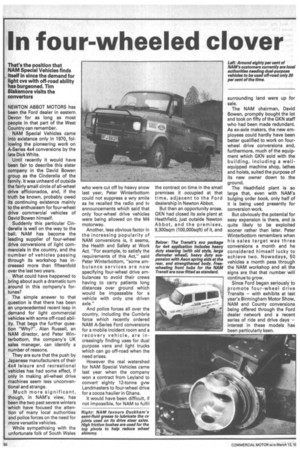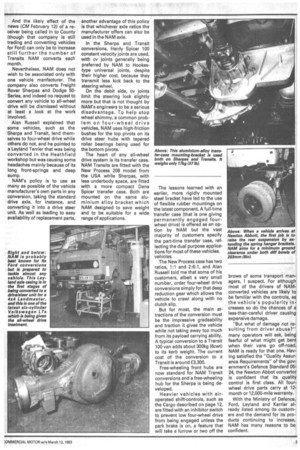In four-wheeled clover
Page 52

Page 53

If you've noticed an error in this article please click here to report it so we can fix it.
NEWTON ABBOT MOTORS has been the Ford dealer in eastern Devon for as long as most people in that part of the West Country can remember.
NAM Special Vehicles came into existence only in 1970, following the pioneering work on A-Series 4x4 conversions by the late Dick White.
Until recently it would have been fair to describe this sister company in the David Bowen group as the Cinderella of the family. It was unheard of outside the fairly small circle of all-wheel drive afficionados, and, if the truth be known, probably owed its continuing existence mainly to the enthusiasm for four-wheel drive commercial vehicles of David Bowen himself.
Suddenly this particular Cinderella is well on the way to the ball. NAM has become the leading supplier of four-wheel drive conversions of light commercials in the country, and the number of vehicles passing through its workshop has increased more than fifteenfold over the last two years.
What could have happened to bring about such a dramatic turn around in this company's fortunes?
The simple answer to that question is that there has been an unprecedented recent leap in demand for light commercial vehicles with some off-road ability. That begs the further question "Why?". Alan Russell, an NAM director, and Peter Winterbottom, the company's UK sales manager, can identify a number of reasons.
They are sure that the push by Japanese manufacturers of their 4x4 leisure and recreational vehicles has had some effect, if only in making all-wheel drive machines seem less unconventional and strange.
Much more significant, though, in NAM's view, has been the two past severe winters which have focused the attention of many local authorities and police forces on the need for more versatile vehicles.
While sympathising with the unfortunate folk of South Wales who were cut off by heavy snow last year, Peter Winterbottom could not suppress a wry smile as he recalled the radio and tv announcements which said that only four-wheel drive vehicles were being allowed on the M4 motorway.
Another, less obvious factor in the increasing popularity of NAM conversions is, it seems, the Health and Safety at Work Act. "For example, to satisfy the requirements of this Act," said Peter Winterbottom, "some ambulance services are now specifying four-wheel drive ambulances to avoid their crews having to carry patients long distances over ground which would be impassable for a vehicle with only one driven axle."
And police forces all over the country, including the Cumbria force which recently ordered NAM A-Series Ford conversions for a mobile incident room and a recovery vehicle, are increasingly finding uses for dual purpose vans and light trucks which can go off-road when the need arises.
However the real watershed for NAM Special Vehicles came last year when the company won a contract from Leyland to convert eighty 12-tonne gvw Landmasters to four-wheel drive for a cocoa haulier in Ghana.
It would have been difficult, if not impossible, for NAM to fulfil the contract on time in the small premises it occupied at that time, adjacent to the Ford dealership in Newton Abbot.
But then an opportunity arose. GKN had closed its axle plant at Heathfield, just outside Newton Abbot, and the premises, 9,300sqm (100,000sqft) of it, and surrounding land were up for sale.
The NAM chairman, David Bowen, promptly bought the lot and took on fifty of the GKN staff who had been made redundant. As ex-axle makers, the new employees could hardly have been better qualified to work on fourwheel drive conversions and, furthermore, much of the equipment which GKN sold with the building, including a wellequipped machine shop, lathes and hoists, suited the purpose of its new owner down to the ground.
The Heathfield plant is so large that, even with NAM's bulging order book, only half of it is being used presently for conversion work.
But obviously the potential for easy expansion is there, and is quite likely to be exploited sooner rather than later. Peter Winterbottom remembers when his sales target was three conversions a month and he considered himself lucky to achieve two. Nowadays, 50 vehicles a month pass through the NAM workshop and all the signs are that that number will continue to grow.
Since Ford began seriously to promote four-wheel drive Transits — with exhibits at last year's Birmingham Motor Show, NAM and County conversions being offered through the Ford dealer network and a recent series of ride and drive days — interest in these models has been particularly keen.
And the likely effect of the news (CM February 12) of a receiver being called in to County (though that company is still trading and converting vehicles for Ford) can only be to increase still further the number of Transits NAM converts each month.
Nevertheless, NAM does not wish to be associated only with one vehicle manfacturer. The company also converts Freight Rover Sherpas and Dodge 50Series, and indeed no request to convert any vehicle to all-wheel drive will be dismissed without at least a look at the work involved.
Alan Russell explained that some vehicles, such as the Sherpa and Transit, lend themselves to four-wheel drive while others do not, and he pointed to a Leyland Terrier that was being converted in the Heathfield workshop but was causing some headaches mainly because of its long front-springs and deep sump.
NAIVI's policy is to use as many as possible of the vehicle manufacturer's own parts in any conversion, taking the standard drive axle, for instance, and converting it into a drive steer unit. As well as leading to easy availability of replacement parts, another advantage of this policy is that whichever axle ratios the manufacturer offers can also be used in the NAM axle.
In the Sherpa and Transit conversions, Hardy Spicer 100 constant velocity joints are used, with cv joints generally being preferred by NAM to Hookestype universal joints, despite their higher cost, because they transmit less kick back to the steering wheel.
On the debit side, cv joints limit the steering lock slightly more but that is not thought by NAM's engineers to be a serious disadvantage. To help stop wheel shimmy, a common problem on four-wheel drive vehicles, NAM uses high-friction bushes for the top pivots on its drive steer hubs with tapered roller bearings being used for the bottom pivots.
The heart of any all-wheel drive system is its transfer case. NAM Transits are fitted with the New Process 208 model from the USA while Sherpas, with less underbody space, are fitted with a more compact Dana Spicer transfer case. Both are mounted on the same aluminium alloy bracket which NAM designed to save weight and to be suitable for a wide range of applications. The lessons learned with an earlier, more rigidly mounted steel bracket have led to the use of flexible rubber mountings on the latest component. A full-time transfer case (that is one giving permanently engaged fourwheel drive) is offered as an option by NAM but the vast majority of customers specify the part-time transfer case, reflecting the dual purpose applications for most of these vehicles. vehicles.
The New Process case has two ratios, 1:1 and 2:6:1, and Alan Russell told me that some of his customers, albeit a very small number, order four-wheel drive conversions simply for that deep reduction gear which allows the vehicle to crawl along with no clutch slip.
But for most, the main attractions of the conversion must be the impressive gradeability and traction it gives the vehicle while not taking away too much from its payload carrying ability. A typical conversion to a Transit 100 van adds about 300kg (6cwt) to its kerb weight. The current cost of the conversion to a Transit is around £3,300.
Free-wheeling front hubs are now standard for NAM Transit conversions and a free-wheeling hub for the Sherpa is being developed.
Heavier vehicles with airoperated shift-controls, such as the Cargo described on page 12, are fitted with an inhibitor switch to prevent low four-wheel drive from being engaged unless the park brake is on, a feature that will take a furrow or two off the brows of some transport managers, I suspect. For although most of the drivers of NAMconverted vehicles are likely to be familiar with the controls, as the vehicle's popularity increases so do the chances of a less-than-careful driver causing expensive damage.
"But what of damage not resulting from driver abuse?" many operators will ask, being fearful of what might get bent when their vans go off-road. NAM is ready for that one. Having satisfied the "Quality Assurance Requirements" of the government's Defence Standard 0524, the Newton Abbot convertor is confident that its quality control is first class. All fourwheel drive parts carry at 12month or 12,000-mile warranty.
With the Ministry of Defence, Ford, Leyland and Karrier already listed among its customers and the demand for its products continuing to increase, NAM has many reasons to be confident.




























































































